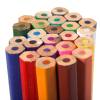

Focus Here
Achieve This
EXERCISE

FITNESS
NUTRITION

ENERGY
WEIGHT

SELF-CONFIDENCE
STRESS MGMT

FLEXIBILITY
RECREATION

CREATIVITY
REST/SLEEP

MENTAL CLARITY
RELATIONSHIPS

FULFILLMENT
SURROUNDINGS

ORGANIZED
Health and Wellness Coaching
Change your mind to change your life.
Chinese Handcuffs
An In Balance Original Article
The more you push against something the stronger it gets. It's like having a cupcake waiting for you in the refrigerator. You try to ignore it, but it keeps calling you. And in the end you feel the only solution is to eat the cupcake and be done with it. At least the siren song of chocolate is no longer distracting you, and you can continue with your pleasant evening in peace.
I find my clients are better able to keep something in mind if I give them a thought-model to visualize. For the example above, I might have them visualize Chinese handcuffs. Do you remember playing with Chinese handcuffs as a child? It is a simple tube made of colorful strips of burlap woven together. You stick your finger in the tube and pull on the other end; your finger is now stuck in the tube. One can easily imagine a Chinese constable with one finger in the tube slipping the other end of the tube onto your finger and pulling it tight. You now have to follow the constable wherever he goes, or risk having your finger pulled out. Pretty effective "handcuffs."
The key to this visualization, of course, is recognizing that struggling against the tube only makes it tighter. But if you relax and give in to the tube, it expands and you can easily slip your finger out of it. Resistance creates tension, but yielding allows the constriction to relax. It's like the cupcake example above. The more we shout "No!" at it, the more fixed it becomes in our mind. This is natural, of course, but self-defeating. We should instead fix our thoughts on creative solutions to our problem, to positive steps we can take to achieve our goal, instead of focusing on what we don't want in our lives. But this is easier said than done, isn't it?
We usually find it easier to identify what we don't want than what we do. Like Goldilocks, this bed is too hard, that bed is too soft; and this porridge is too hot, while that porridge is too cold. We don't want to vacation where it not safe, or where the food is too strange and exotic, or perhaps where no one speaks English. So just what do we want? And how do we go about getting there?
For starters, we need to stop focusing on what we don't want. Whether it be clutter, procrastination, excess weight, insomnia or the next drink of alcohol - to name just a few examples - we need to relax. We need to think about Chinese handcuffs, and remember that our focus on what is making us unhappy is self-defeating. Instead, we need to focus our attention on constructive activities that will contribute to our obtaining our goal.
And that is where a professional health and wellness coach comes in.
A professional health and wellness coach does not advocate ignoring your "problem." In fact, it is usually advantageous to delve into your issue and explore it thoroughly, to root out the possible origins and bring into the light the many related issues that may be contributing to your inability to obtain your desired goal on your own. A coach is a trained and experienced listener, a refuge, a safe and private place to "let it all hang out."
Isn't that a relaxing thought?
As with most tasks in life, there is the preparation phase, and the action phase. In cooking you first detail your menu and collect your ingredients, before you can actually cook the meal. In a construction project you draft the blueprint and gather the materials on the worksite, before you can build the structure. In a car repair you have to first remove the faulty piece and clean and prepare the affected area, before you can install the replacement part.
A discussion of your issues and desired outcomes is the "preparation" phase. This phase may also include tiny steps that inspire or motivate you. When that feels complete, it is time to move into the "action" phase. When you enter this phase it is time to invoke the thought-model of the Chinese handcuffs, and resist the temptation to focus on your issues obsessively. Instead, devote your energy to the solution, or to the movement in that direction. In most cases, the solution is something you and your coach have worked out together. Typically, you actually come up with your own baby steps, as a result of the questions and broader perspectives brought forward by your coach. Your coach may also request one or more practical actions to take, and you have agreed to apply these practices with reasonable diligence. That is your job; to focus on the outcome, not the issue.
A thought-model is a very simple yet powerfully effective method to change one's behavior. It is but one tool in a whole toolbox carried by your coach. Add to that compassion, empathy, listening and helping skills, organization, time-management, and a host of other qualities a professional health and wellness coach brings to the table, and you have an excellent partner whose job is to help you achieve what you yourself desire most: personal success.
Use your Back button to return to the Excellent Articles page.
Disclaimer: As a Health Coach, I will never attempt to diagnose, treat, make claims, prevent or cure any disease or condition. I advise my clients that Health Coaching is not intended to substitute for the advice, treatment and/or diagnosis of a qualified licensed health care professional.